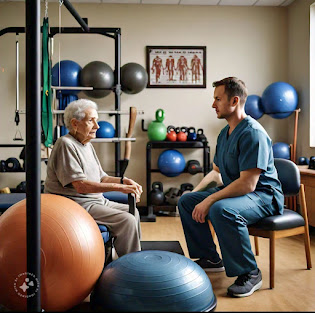The benefits of getting treated with physical therapy include:
1. Pain Relief: Reduces pain and discomfort without relying on medication.
2. Improved Mobility: Enhances movement, flexibility, and range of motion.
3. Injury Prevention: Identifies and addresses potential issues before they become severe.
4. Surgery Prevention: Can help avoid surgery by addressing underlying issues.
5. Rehabilitation: Aids in recovery after surgery, injury, or illness.
6. Chronic Condition Management: Helps manage chronic conditions like diabetes, arthritis, and heart disease.
7. Improved Balance and Coordination: Reduces the risk of falls and injuries.
8. Enhanced Athletic Performance: Optimizes movement and function for athletes.
9. Education and Empowerment: Teaches patients about their condition and self-management techniques.
10. Cost-Effective: Reduces healthcare costs by avoiding unnecessary tests and treatments.
11. Improved Mental Health: Addresses mental health concerns like depression and anxiety.
12. Increased Independence: Enables individuals to perform daily tasks and maintain independence.
Physical therapy offers a holistic approach to healthcare, focusing on empowering patients to take control of their well-being and achieve optimal physical function.
What is physical therapy best for?
Physical therapy is best for:
1. Injury Rehabilitation: Recovering from injuries, such as sports injuries, workplace injuries, or accidents.
2. Chronic Pain Management: Managing chronic pain conditions like arthritis, fibromyalgia, or lower back pain.
3. Post-Surgery Recovery: Recovering from surgeries, such as joint replacements, fractures, or spinal surgeries.
4. Neurological Conditions: Managing conditions like stroke, Parkinson's disease, multiple sclerosis, or spinal cord injuries.
5. Mobility and Balance Issues: Improving mobility, balance, and coordination.
6. Sports Performance Enhancement: Enhancing athletic performance, improving flexibility, and reducing the risk of injuries.
7. Pediatric Conditions: Treating developmental delays, cerebral palsy, or other pediatric conditions.
8. Geriatric Care: Managing age-related conditions, such as osteoporosis, balance disorders, or Alzheimer's disease.
9. Cardiovascular and Pulmonary Rehabilitation: Recovering from heart attacks, heart surgeries, or pulmonary diseases.
10. Preventative Care: Preventing injuries, improving posture, and promoting overall wellness.
Physical therapy is a versatile and effective treatment approach that can benefit individuals with various conditions, helping them achieve optimal physical function and improve their quality of life.
Why do patients go to physical therapy?
Patients go to physical therapy for various reasons, including:
1. Injury or Trauma: Recovery from injuries, accidents, or surgeries.
2. Chronic Pain: Management of chronic pain conditions like arthritis, fibromyalgia, or lower back pain.
3. Surgery Rehabilitation: Recovery from joint replacements, fractures, or spinal surgeries.
4. Neurological Conditions: Management of conditions like stroke, Parkinson's disease, multiple sclerosis, or spinal cord injuries.
5. Mobility and Balance Issues: Improvement of mobility, balance, and coordination.
6. Sports Performance Enhancement: Enhancement of athletic performance, flexibility, and injury prevention.
7. Pediatric Conditions: Treatment of developmental delays, cerebral palsy, or other pediatric conditions.
8. Geriatric Care: Management of age-related conditions, such as osteoporosis, balance disorders, or Alzheimer's disease.
9. Cardiovascular and Pulmonary Rehabilitation: Recovery from heart attacks, heart surgeries, or pulmonary diseases.
10. Preventative Care: Prevention of injuries, improvement of posture, and promotion of overall wellness.
11. Work-Related Injuries: Recovery from work-related injuries or prevention of work-related musculoskeletal disorders.
12. Pregnancy and Postpartum Care: Relief from pregnancy-related discomforts and postpartum recovery.
Patients seek physical therapy to achieve optimal physical function, reduce pain, and improve their overall quality of life.
How successful is physical therapy?
Physical therapy is a highly successful treatment approach, with various studies and research demonstrating its effectiveness. Here are some success rates and statistics:
1. Pain Reduction: 70-90% of patients experience significant pain reduction.
2. Functional Improvement: 80-90% of patients show improvement in functional abilities.
3. Injury Recovery: 85-90% of patients recover from injuries with physical therapy.
4. Surgery Prevention: 50-70% of patients avoid surgery through physical therapy.
5. Patient Satisfaction: 80-90% of patients report satisfaction with physical therapy treatment.
6. Return to Work: 70-80% of workers return to work after physical therapy.
7. Improved Mobility: 80-90% of patients experience improved mobility and range of motion.
8. Reduced Medication: 50-70% of patients reduce or eliminate pain medication.
9. Improved Quality of Life: 80-90% of patients report improved overall quality of life.
Keep in mind that success rates may vary depending on the specific condition, patient compliance, and treatment approach. Physical therapy is a personalized treatment, and outcomes may differ from person to person. However, overall, physical therapy is a highly effective treatment option for various conditions and injuries.
Does physical therapy help relieve pain from arthritis?
Yes, physical therapy can help relieve pain from arthritis. Physical therapy can:
1. Improve joint mobility: Gentle exercises and manual therapy can increase range of motion and reduce stiffness.
2. Strengthen surrounding muscles: Strengthening muscles around the affected joint can provide support and stability, reducing pain.
3. Improve joint alignment: Physical therapy can help improve joint alignment, reducing stress and strain on the joint.
4. Enhance flexibility: Regular exercises can improve flexibility, making daily activities easier.
5. Reduce inflammation: Physical therapy can help reduce inflammation, which contributes to arthritis pain.
6. Improve balance and coordination: Physical therapy can help improve balance and coordination, reducing the risk of falls.
7. Manage weight: Physical therapy can help with weight management, reducing pressure on joints.
8. Use modalities: Physical therapists may use modalities like heat, cold, or electrical stimulation to reduce pain.
Physical therapy can help manage arthritis pain and improve function, allowing individuals to:
- Perform daily activities with more ease
- Reduce reliance on pain medication
- Improve overall quality of life
It's essential to work with a physical therapist to develop a personalized exercise program and treatment plan.

Comments
Post a Comment